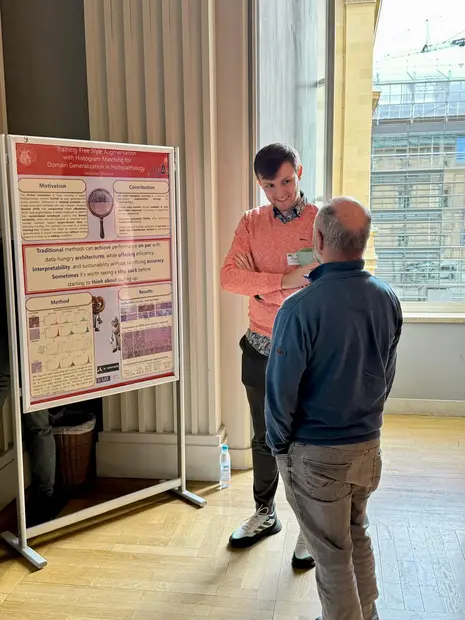Rediscovering the Classics: Our Contribution at the Bavarian Conference on AI in Medicine 2025
AI in Medicine: A Bavarian Hub for Innovation and Collaboration
On October 27–28, 2025, the Bavarian Conference on AI in Medicine brought together researchers, clinicians, and innovators at the Bavarian Academy of Sciences and Humanities (BAdW) in Munich. Organized within the growing BAIOSPHERE ecosystem, the event served as a meeting point for AI experts and medical researchers from across Bavaria and beyond.
With keynote lectures by internationally renowned scientists including Eric Topol, Fabian Theis, Mihaela van der Schaar, and Islem Rekik, the conference covered topics ranging from agentic AI and graph intelligence to large language models in healthcare.
Over the two days, discussions revolved around bridging the gap between fundamental AI innovation and clinical application, aligning perfectly with the conference’s mission to foster collaboration across academia and industry. Panel discussions and poster sessions further emphasized Bavaria’s strong role as a hub for AI-driven medical research, where ideas flow freely between disciplines and where young scientists actively shape the future of healthcare technology.
Our Contribution: Training-Free Style Augmentation for Robust Histopathology AI
Amid this inspiring environment, our PhD candidate Sebastian Doerrich presented the poster “Training-Free Style Augmentation with Histogram Matching for Domain Generalization in Histopathology.”
The work builds on our lab’s continuing efforts to address one of the core challenges in medical imaging AI: domain generalization.
Deep learning models often struggle when applied to data from new hospitals or scanners, especially in digital pathology, where staining and imaging conditions can vary widely. Such variability can lead to performance drops, hindering real-world deployment.
Building on insights from our MICCAI 2024 paper on generative style augmentation using self-supervised Vision Transformers, this new study takes a step back (and forward) by revisiting classical image processing. The method employs histogram matching to transfer the color distribution between histopathology images, effectively simulating realistic staining variations without any additional training or external data.
Despite its simplicity, this approach proved highly effective. It preserves anatomical fidelity, avoids hallucinations common in generative methods, and operates in real time; making it ideal for both data augmentation during training and robust alignment during inference.
By highlighting the untapped potential of traditional techniques within modern AI pipelines, this work advocates for a more interpretable, efficient, and clinically viable path to domain generalization.
The corresponding abstract can be found here(63.7 KB).
Insights from the Conference
Throughout the sessions, a clear trend emerged: responsible and translational AI is taking center stage. From Mihaela van der Schaar’s keynote on Agentic AI to Eric Topol’s vision of AI transforming healthspan and longevity, the conversation has shifted from proof-of-concept models to deployable, patient-centered solutions.
The poster sessions, in particular, showcased the diversity of approaches flourishing across Bavaria’s AI-med ecosystem: from generative models for disease discovery to telemonitoring and AI-assisted clinical decision support.
Networking breaks and informal discussions highlighted not only the scientific but also the collaborative spirit of the Bavarian research community, bridging universities, hospitals, and industry partners.
![[Translate to English:] [Translate to English:]](/fileadmin/_processed_/9/2/csm_conference_bayAI_thumbnail_f29ceb1126.webp)

